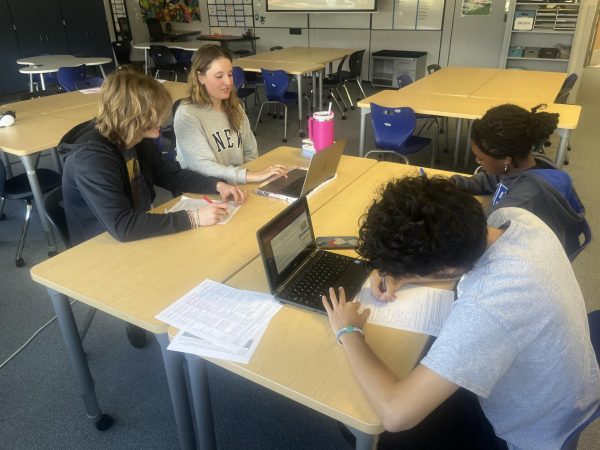Feud Brews Between Paper and Digital Work
Is pen-and-paper superior or is digital work the future?
In the past, homework would create a vision from photocopied worksheets and loose-leaf paper. However, in the modern world of education, many assignments also take a digital format where students can complete them anywhere and turn them in at any time. Today, students and teachers often debate which is more beneficial.
The format that education has taken has seen a drastic shift since the COVID-19 pandemic since education in all its forms has transitioned into a more prominent digital form. Teachers and students alike have adjusted and adapted to this new reality of learning.
“Five years ago I would have answered that differently, I would have said 100% paper. But now, I’m probably more like, ‘whatever, we’ll do both’… The AP exam this year is going to be digital, so we’re practicing typing now,” history teacher Ronald Gorr noted.
There are certain reasons that paper could be better than digital including ensuring that internet access is optional for anyone to complete the assignment, whereas tried-and-true paper assignments do not require that.
“The main reason is that you can pull out a piece of paper anywhere and work on it… You don’t need to have internet access,” Gorr explained.
Furthermore, Gorr believes that paper assignments may result in greater student focus.
“I think that there is a tactile connection to paper writing that makes it different from typing… And, ‘cause I’m old, paper is just more comfortable for me,” Gorr added.
Studies new and old have shown, in various ways, that students of all ages learn more when taking notes and doing work on paper as opposed to typing. This is partially because handwriting forces students to shorten content and understand it conceptually.
“In a behavioral study, Mayer et al. (2020) compared the alphabet learning capacity in preschool children trained by handwriting with a pencil, handwriting with a stylus, and typing on a keyboard during 7 weeks. They showed that handwriting with a pencil improved the performance in letter knowledge and visuospatial skills compared with keyboarding,” a study in Frontiers in Human Neuroscience entitled Advantage of Handwriting Over Typing on Learning Words: Evidence From an N400 Event-Related Potential Index stated.
However, digital assignments are a favorite for some students and teachers because of there familiarity and convenience.
“I feel most students probably prefer something digital, in their world, it’s a little easier. There are benefits to digital stuff, though. I sometimes assign digital quizzes, which students like, and they grade themselves automatically, which is really convenient,” Gorr admitted.
Similarly, students have grown accustomed to typing and prefer it over the foreign feeling of handwriting, which feels less familiar.
“Digital [gives me more productivity]. I don’t like handwriting, and also I can look up stuff,” sophomore Conner Pietrzak opined.
In the end, whether to do paper or digital work is likely just a matter of personal preference for each student. Each person’s brain functions differently and different students are accustomed to different methods.
“Do I think it’s better or worse? Probably not. I think you could still learn from both mediums. I don’t think there’s one way to learn; I think you can learn from an online class as well as an in-person class… I very much think it’s preference-based,” Gorr concluded.
The debate on whether a paper or digital medium for assignments is superior rages and each student at AAHS surely has an opinion surrounding it. As the landscape of education is constantly changing, students and teachers should be prepared to adapt to their productivity can continue to flourish, whichever way they lean.

Hi, my name is Caleb, I am a sophomore here at Air Academy. This is my first time trying journalism. I enjoy playing video games, biking, and more. I run...



















Josie Robles • Mar 23, 2023 at 2:13 pm
Fascinating topic!
Emily Greer • Mar 15, 2023 at 2:09 pm
Well done, Caleb! This article is well thought-out and shows both sides accurately.